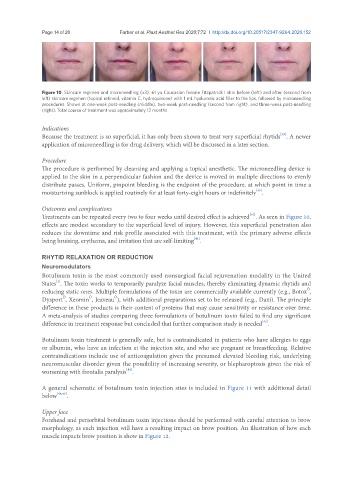Page 864 - Read Online
P. 864
Page 14 of 28 Farber et al. Plast Aesthet Res 2020;7:72 I http://dx.doi.org/10.20517/2347-9264.2020.152
Figure 10. Skincare regimen and microneedling (x3). 61 yo Caucasian female Fitzpatrick I skin before (left) and after (second from
left) skincare regimen (topical retinoid, vitamin C, hydroquinone) with 1 mL hyaluronic acid filler to the lips, followed by microneedling
procedures. Shown at one-week post-needling (middle), two-week post-needling (second from right), and three-week post-needling
(right). Total course of treatment was approximately 12 months
Indications
[39]
Because the treatment is so superficial, it has only been shown to treat very superficial rhytids . A newer
application of microneedling is for drug delivery, which will be discussed in a later section.
Procedure
The procedure is performed by cleansing and applying a topical anesthetic. The microneedling device is
applied to the skin in a perpendicular fashion and the device is moved in multiple directions to evenly
distribute passes. Uniform, pinpoint bleeding is the endpoint of the procedure, at which point in time a
[40]
moisturizing sunblock is applied routinely for at least forty-eight hours or indefinitely .
Outcomes and complications
[40]
Treatments can be repeated every two to four weeks until desired effect is achieved . As seen in Figure 10,
effects are modest secondary to the superficial level of injury. However, this superficial penetration also
reduces the downtime and risk profile associated with this treatment, with the primary adverse effects
[41]
being bruising, erythema, and irritation that are self-limiting .
RHYTID RELAXATION OR REDUCTION
Neuromodulators
Botulinum toxin is the most commonly used nonsurgical facial rejuvenation modality in the United
[1]
States . The toxin works to temporarily paralyze facial muscles, thereby eliminating dynamic rhytids and
Ò
reducing static ones. Multiple formulations of the toxin are commercially available currently (e.g., Botox ,
Ò
Ò
Ò
Dysport , Xeomin , Jeaveau ), with additional preparations set to be released (e.g., Daxi). The principle
difference in these products is their content of proteins that may cause sensitivity or resistance over time.
A meta-analysis of studies comparing three formulations of botulinum toxin failed to find any significant
difference in treatment response but concluded that further comparison study is needed .
[42]
Botulinum toxin treatment is generally safe, but is contraindicated in patients who have allergies to eggs
or albumin, who have an infection at the injection site, and who are pregnant or breastfeeding. Relative
contraindications include use of anticoagulation given the presumed elevated bleeding risk, underlying
neuromuscular disorder given the possibility of increasing severity, or blepharoptosis given the risk of
[43]
worsening with frontalis paralysis .
A general schematic of botulinum toxin injection sites is included in Figure 11 with additional detail
below [44,45] .
Upper face
Forehead and periorbital botulinum toxin injections should be performed with careful attention to brow
morphology, as each injection will have a resulting impact on brow position. An illustration of how each
muscle impacts brow position is show in Figure 12.

